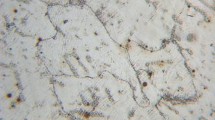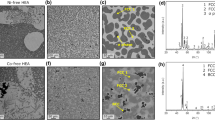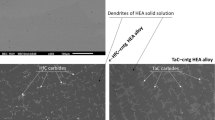Abstract
Eight model high entropy alloys (HEAs) in the CoCrFeMnNi family (including one alloy each in the CoCrFeNi and CoFeMnNi subfamilies) were made, prepared, and exposed to laboratory air for 1100 h at 650°C and 750°C. Two commercial alloys, nickel-base superalloy 230 (N06230) and austenitic stainless steel 304H (S30409), were simultaneously exposed for comparison. Mass change oxidation kinetics were measured and cross-sections of exposed samples were observed. Seven of these HEAs contained much more Mn (12–24 wt.%) than is found in commercial heat-resistant stainless steels and superalloys. The oxidation resistance of CoCrFeNi was excellent and comparable to 304H at 650°C and only slightly worse at 750°C. The thin oxide scale on CoCrFeNi was primarily Cr oxide (presumably Cr2O3) with some Mn oxide at the outer part of the scale. The CoCrFeMnNi HEAs all experienced more rapid oxidation than CoCrFeNi and, especially at 750°C, experienced oxide scale spallation. The addition of Y in the alloy to lower S improved the oxidation resistance of these HEAs. Alloy CoFeMnNi, without Cr, experienced much higher oxidation rates and scale spallation than the Cr-containing alloys. A linear regression analysis of the log of the parabolic rate constant, log(kp), as functions of wt.% Cr and Mn found a good correlation for the compositional dependence of the oxidation rate constant, especially at 650°C. Mn was found to be more detrimental increasing log(k p) than Cr was helpful reducing log(k p). If CoCrFeMnNi HEAs are to be used in high temperature oxidizing environments, then examining lower levels of Mn, while maintaining Cr levels, should be pursued.















Similar content being viewed by others
References
D.B. Miracle, J.D. Miller, O.N. Senkov, C. Woodward, M.D. Uchic, and J. Tiley, Entropy 16, 494 (2014).
J.-W. Yeh, JOM 65, 1759 (2013).
M.-H. Tsai and J.-W. Yeh, Mater. Res. Lett. 2, 107 (2014).
Y. Zhang, T.T. Zuo, T. Zhi, M.C. Gao, K.A. Dahmen, P.K. Liaw, and Z.P. Lu, Prog. Mater Sci. 61, 1 (2014).
A.K. Singh and A. Subramaniam, J. Alloys Compd 587, 113 (2014).
K.Y. Tsai, M.H. Tsai, and J.W. Yeh, Acta Mater. 61, 4887 (2013).
M.C. Gao and D.E. Alman, Entropy 15, 4504 (2013).
B. Gleeson and M.A. Harper, Lifetime Modelling of High Temperature Corrosion Processes (London: Institute of Materials, 2001), pp. 167–177.
G.R. Holcomb and D.E. Alman, Scr. Mater. 54, 1821 (2006).
J. Gilewicz-Olter, Z. Zurek, J. Dudala, J. Lis, M. Hoa, and M. Wolter, J. Phase Equilib. Diffus. 26, 561 (2005).
D. Young: High Temperature Oxidation and Corrosion of Metals (Elsevier, New York, NY, 2008), pp. 229–230, 350.
P.D. Jablonski and J.A. Hawk: in Proceedings of the 2013 International Symposium on Liquid Metal Processing & Casting, ed. M.J.M. Krane, A. Jordy, R.L. Williamson, and J.J. Beaman (John Wiley & Sons, Hoboken, NJ: 2013), pp. 329-332.
P.D. Jablonski and C.J. Cowen, Metall. Mater. Trans. B 40, 182 (2009).
Haynes 230 Alloy, H-3135C (Kokomo: Haynes International, 2008).
B.A. Pint, Oxid. Met. 45, 1 (1996).
P.Y. Hou, Mater. Sci. Forum 696, 39 (2011).
B. Pieraggi, Oxid. Met. 27, 177 (1987).
P. Kofstad, High Temperature Corrosion (New York: Elsevier Science Publishing, 1988), pp. 132–161.
G.R. Holcomb, P.D. Jablonski, and P. Wang: Proceedings of the 7th International Symposium on Superalloy 718 and Derivatives, ed. E.A. Ott, J.R. Groh, A. Banik, I. Dempster, T.P. Gabb, R. Helmink, X. Liu, A. Mitchell, G.P. Sjöberg, and A. Wusatowska-Sarnek (Hoboken: Wiley, 2010), pp. 947–960.
T.M. Butler, J.P. Alfano, R.L. Martens, and M.L. Weaver, JOM 16, 246 (2015).
D.P. Whittle and J. Stringer, Philos. Trans. R. Soc. Lond. A295, 309 (1980).
P.Y. Hou: in John Stringer Symposium on High Temperature Corrosion, ed. P. T. Tortorelli, I. G. Wright, and P. Y. Hou (Materials Park: ASM International, 2003), pp. 164–173.
J.O. Andersson, T. Helander, L. Höglund, P.F. Shi, and B. Sundman, Calphad 26, 273 (2002).
Thermo-Calc Software TCFE7 Steels/Fe-alloys database version 7, http://www.thermocalc.com/products-services/databases/thermodynamic/. Accessed 5 November 2014.
C.W. Bale, A.D. Pelton, W.T. Thompson, G. Eriksson, K. Hack, P. Chartrand, S. Decterov, I-H. Jung, J. Melançon, and S. Petersen, FactSage 6.4, Thermfact and GTT-Technologies (2013).
Acknowledgements
This work was funded by the Cross-Cutting Technologies Program at the National Energy Technology Laboratory (NETL) – Strategic Center for Coal, managed by Robert Romanosky (Technology Manager) and Charles Miller (Technology Monitor). The Research was executed through NETL’s Office of Research and Development’s Innovative Process Technologies (IPT) Field Work Proposal. This report was prepared as an account of work sponsored by the United States Government. Neither the United States Government nor any agency thereof, nor any of their employees, makes any warranty, express or implied, or assumes any legal liability or responsibility for the accuracy, completeness, or usefulness of any information, apparatus, product, or process disclosed, or represents that its use would not infringe privately owned rights. Reference herein to any specific commercial product, process, or service by trade name, trademark, manufacturer, or otherwise does not necessarily constitute or imply its endorsement, recommendation, or favoring by the United States Government or any agency thereof.
Author information
Authors and Affiliations
Corresponding author
Rights and permissions
About this article
Cite this article
Holcomb, G.R., Tylczak, J. & Carney, C. Oxidation of CoCrFeMnNi High Entropy Alloys. JOM 67, 2326–2339 (2015). https://doi.org/10.1007/s11837-015-1517-2
Received:
Accepted:
Published:
Issue Date:
DOI: https://doi.org/10.1007/s11837-015-1517-2




